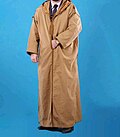| Revision as of 16:47, 23 January 2024 view sourceNumidae (talk | contribs)3 edits added production info for QashabiyaTags: Reverted Visual edit← Previous edit | Revision as of 17:31, 23 January 2024 view source Skitash (talk | contribs)Extended confirmed users, Pending changes reviewers, Rollbackers11,823 edits Undid revision 1198256956 by Numidae (talk) unsourcedTags: Undo RevertedNext edit → | ||
| Line 16: | Line 16: | ||
| == Description == | == Description == | ||
| ] | ] | ||
| The word Qashabiya is derived from ]:"gausapa", a term that is even still conserved today as "gosaba" in ], to refer to a shirt. It is a long brown garment with a hood that is comparable to the ] but considerably thicker. This outfit from east Algeria is particularly popular among residents of Algeria's central and eastern semi-arid areas ( |
The word Qashabiya is derived from ]:"gausapa", a term that is even still conserved today as "gosaba" in ], to refer to a shirt. It is a long brown garment with a hood that is comparable to the ] but considerably thicker. This outfit from east Algeria is particularly popular among residents of Algeria's central and eastern semi-arid areas (], ], ], ], ], ], ], ] ...). | ||
| It is part of the outfits worn by the ] and was subsequently exported throughout the country and even crossed borders to neighboring countries. Modern Kachabia come in a variety of colors and designs and may be worn by both men and women, despite the fact that it is still considered a masculine outfit. | It is part of the outfits worn by the ] and was subsequently exported throughout the country and even crossed borders to neighboring countries. Modern Kachabia come in a variety of colors and designs and may be worn by both men and women, despite the fact that it is still considered a masculine outfit. | ||
| == Production == | |||
| ] | |||
| ] | |||
| Qashabiya is hand woven. After washing well and removing all impurities and dust stuck to the raw material and after drying it, it is directed to mixing using traditional means using thinthhar (]) so that the colors of the raw material are homogeneous. At an advanced stage, the first steps of spinning begin, where the wool or lint is smelled manually, that is, mixed by A two-part manual machine called the "Qardash". The wool or hair is cut into twistable parts and then these parts are formed into threads of thin or medium thickness depending on the product to be woven, using a manual machine called the spindle, through which the threads are twisted through a circular motion. For the spindle, the amount of raw material needed for production is determined by the weaver’s estimate. | |||
| == See also == | == See also == | ||
Revision as of 17:31, 23 January 2024
Algerian clothing Men wearing the qashabiya Men wearing the qashabiya | |
| Material | Camel hair and wool |
|---|---|
| Place of origin | Algeria |
A qashabiya (Berber: ⵇⴰⵛⴰⴱⵉⵢⴰ, Template:Lang-ar), also styled Kachabia, Kachabiya or kchabia, is a traditional berber Algerian garment most often associated with the Chaoui, and those from Djelfa. It is made of animal hide (horse, hide, sheep hide, bear hide, gazelle hide...etc) in Aures, and the Djelfa variant is made with camel hair and wool, and is held in high esteem by many Algerians because of the warmth it provides during cold winters, especially in the Aures mountains and high plateaus of the Chaouia region where it is produced.
Description

The word Qashabiya is derived from latin:"gausapa", a term that is even still conserved today as "gosaba" in Adrar, to refer to a shirt. It is a long brown garment with a hood that is comparable to the djellaba but considerably thicker. This outfit from east Algeria is particularly popular among residents of Algeria's central and eastern semi-arid areas (Ammi Moussa, Relizane, Chlef, Djelfa, M'sila, Aurès, Biskra, Bou-Saada ...).
It is part of the outfits worn by the Chaoui people and was subsequently exported throughout the country and even crossed borders to neighboring countries. Modern Kachabia come in a variety of colors and designs and may be worn by both men and women, despite the fact that it is still considered a masculine outfit.
See also
References
- Meguellati-Kanoun, Amel; Abdelali-Martini, Malika; Kanoun, Mohamed; Benmebarek, Abdelmadjid; Benidir, Mohamed (2013-12-17). "The potential loss of traditional know-how of qashabiya production in Djelfa, Algeria". In Malika Abdelali-Martini; Aden Aw-Hassan (eds.). Gender Research in Natural Resource Management: Building Capacities in the Middle East and North Africa. Routledge. pp. 37–55. ISBN 978-1-317-91634-5.
- Benmebarek, Abdelmadjid; Larbi Cherfaoui, Mohamed; Ouazane, H.; Abdelali-Martini, Maliki; Meguellati-Kanoun, Amel; Kanoun, Mohamed; Fodil, Souhila (2013-12-17). "Gender and Marketing of qashabiya in Djelfa (Algeria)". In Malika Abdelali-Martini; Aden Aw-Hassan (eds.). Gender Research in Natural Resource Management: Building Capacities in the Middle East and North Africa. Routledge. pp. 56–73. ISBN 978-1-317-91634-5.
| Sufism terminology | ||
|---|---|---|
| Sufis |  | |
| Concepts | ||
| Awrad |
| |
| Waridates | ||
| Misconducts | ||
| Ceremonies | ||
| Arts | ||
| Places | ||
| Objects | ||
This clothing-related article is a stub. You can help Misplaced Pages by expanding it. |